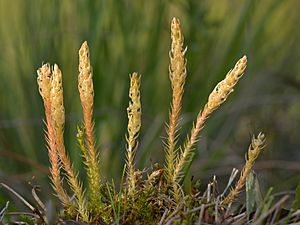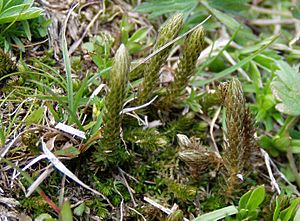Selaginella selaginoides facts for kids
Quick facts for kids Selaginella selaginoides |
|
|---|---|
 |
|
| Scientific classification |
Selaginella selaginoides is a special plant that doesn't have flowers. It belongs to the spikemoss group, which is called Selaginella. You can find this plant in many places across the Northern Hemisphere.
Even though it looks a lot like moss, it's actually a vascular plant. This means it has special tubes inside to carry water and nutrients, just like bigger plants. It's part of a plant group called Lycopodiophyta. People call it by many names, like lesser clubmoss, club spikemoss, northern spikemoss, low spikemoss, and prickly mountain-moss. It has only one close relative, Selaginella deflexa, which grows in Hawaii. These two plants are unique and are like a small family group among all other spikemoss species.
Contents
What Does Selaginella Selaginoides Look Like?
This plant is small and delicate. It grows close to the ground. Its main stems are thin and branch out in different directions. They can grow up to 15 centimeters (about 6 inches) long. These stems usually creep along the ground but then turn upwards near their ends.
Leaves and Stems
The plant has tiny, pointed leaves. They are shaped like triangles and are about 1 to 2 millimeters long. Each leaf has a small, scale-like part called a ligule on its top surface, near where it connects to the stem.
The plant also grows special stems each year that help it reproduce. These stems are stronger than the creeping ones and stand straight up. They are usually 3 to 6 centimeters (about 1 to 2.5 inches) tall and 4 to 6 millimeters wide. If conditions are really good, they can even reach 10 centimeters (about 4 inches) tall. Their leaves are a bit longer than the leaves on the creeping stems. They are arranged in a spiral pattern around the stem and point upwards.
Reproduction: Cones and Spores
The upright stems have yellowish, cone-like structures at their tips. These cones are where the plant makes its spores. The cones usually have two types of spore cases, called sporangia.
The lower part of the cone has larger sporangia. These produce bigger spores called megaspores. The upper part of the cone has smaller sporangia. These produce many tiny spores called microspores. This way, the plant can spread and grow in new places.
Where Does Selaginella Selaginoides Live?

This plant is found almost all around the northern part of the world. You can see it in northern Europe, Asia, and North America. This includes places like Greenland, Iceland, and the Faroe Islands. In Europe, it grows as far south as the Pyrenees mountains, the Apennines, and the Caucasus. In Asia, it reaches Japan. In North America, it can be found as far south as Nevada, Wisconsin, Michigan, and Maine.
Habitat and Environment
Selaginella selaginoides likes damp places. It prefers soils that are neutral to slightly alkaline. You will often find it in mountainous areas. It lives in bogs, along the edges of streams and lakes, on wet cliffs and ledges, in grasslands, and in wet areas between sand dunes.
This plant doesn't do well when there are many tall, dense plants around. It struggles to compete for sunlight and space. In North America, it mostly grows at high elevations, from about 600 to 2900 meters (about 2,000 to 9,500 feet) above sea-level. Sometimes, it can even be found as high as 3800 meters (about 12,500 feet). In Britain, it has been seen from sea-level up to 1065 meters (about 3,500 feet).
Conservation Status
Globally, this plant is not considered an endangered species. However, its numbers have gone down in some areas. This is mainly because of drainage (when water is removed from wet areas) and habitat destruction (when its natural home is damaged). For example, in Britain and Ireland, it had mostly disappeared from low-lying areas by the 1930s. But in the higher, mountainous regions, its population has stayed mostly the same.
See also
 In Spanish: Selaginella selaginoides para niños
In Spanish: Selaginella selaginoides para niños

